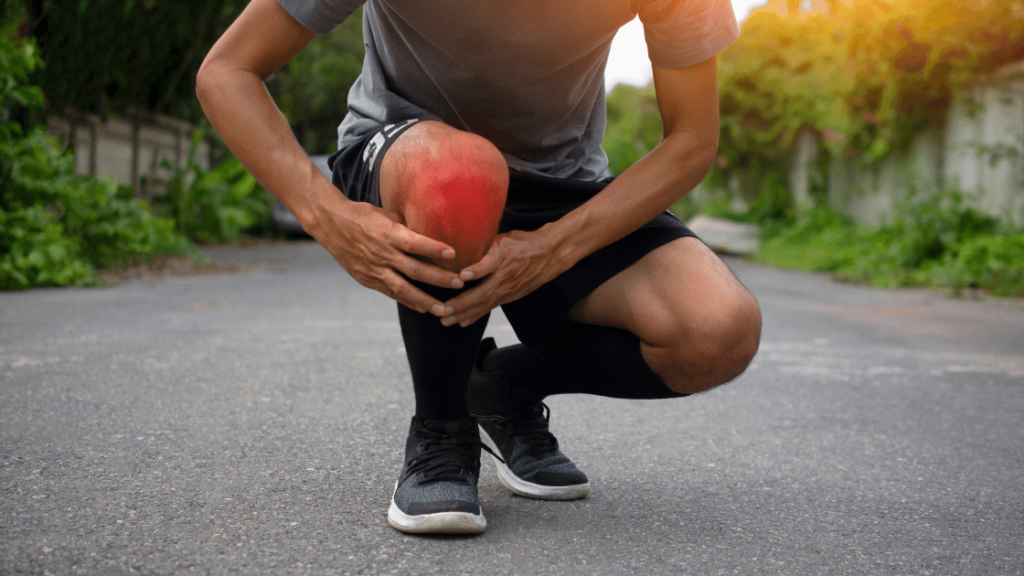What is Runner’s Knee?

The term runner’s knee might sound as straightforward as it gets. Clearly, you’re probably thinking, it must be an unfortunate condition that plagues the knees of people who run too much. But really, that’s a semi inaccurate definition of runner’s knee. In fact, you don’t even have to be a runner to end up with it.
Runner’s knee is an umbrella term that covers all types of knee related pain. Patellofemoral pain syndrome, patellofemoral malalignment, chondromalacia, and iliotibial band syndrome are four different ailments sharing space under this rather sad umbrella.
Other than excessive running, what causes a runner’s knee?
Causes of Runner’s Knee
Overuse
Remember when said iliotibial band syndrome just a few lines ago? That one is almost always caused by overuse. (Click here if you want to read an article I wrote about IT band syndrome!) And that other wordy term I mentioned, patellofemoral pain syndrome, is also caused by overuse. No blog about that one yet, but it will come.
Actually, all the aforementioned types of runner’s knee can result from overuse. But let’s focus on IT band syndrome and patellofemoral pain syndrome for now.
Here’s how overuse leads to IT band syndrome: the repeated bending of the knee can tighten the IT band to such an extent that it starts rubbing up against the thigh bone. It’s not supposed to do that, in case you were wondering. The insertion site of the IT band, just under the knee, feels sharp and tender when this syndrome kicks in. Running, biking, climbing… Any hobby that involves a constantly bending knee can cause this type of runner’s knee.
Now for patellofemoral pain syndrome! This type of runner’s knee is more common in activities that involve jumping or squatting, in addition to overdoing it with the running. The repetitive stress on the knee joint causes aggravation right under the kneecap.
Injury
Chondromalacia, another form of runner’s knee, is usually caused by a fall or direct hit to the knee. A knee fracture or dislocated kneecap can cause the cartilage beneath the patella to deteriorate and soften, causing the kneecap to rub against the bones beneath it… ouch.
Misalignment
In case the name didn’t give it away, patellofemoral malalignment is generally caused by a misaligned leg. Misalignment of the hips, knees, ankles or any other leg bone/joint can lead to all sorts of problems. An unbalanced gait places excessive pressure on certain areas of the leg, and the anterior knee is a common target. A misalignment induced knee injury is often accompanied by stiffness, tenderness, and a crackly noise from the knee.
Muscle Weakness
More specifically, weakness in the thigh and hip muscles. An untoned upper leg can place a lot of stress on the knee when it’s time to work out. Strong quadriceps will help keep the knee in its proper place when the joint is bent or stretched.
Quadricep Tightness
Muscles aren’t so flexible when they’re tensed up. The insertion site of the quadriceps is just above the knee, and its inflexibility will increase the chance of patellar injury.
Weight Gain
Just like with misalignment and weak muscles, excessive weight places uncomfortable amounts of pressure on the knees.
Self-Care for Runner’s Knee
- Rest
-
- Adequate sleep is helpful, but also make sure to rest the knee during the day.
- Avoid running until symptoms improve.
-
- Reduce workout intensity
-
- Once your doctor gives you the OK to continue exercising, start slowly and take it easy on your knees.
-
- Ice therapy
-
- Apply an ice pack to the knee for 10-15 minutes, 3-4 times per day. This will reduce pain and swelling brought on by runner’s knee.
-
- Sports tape
-
- Place kinesiology tape on and around your knees. It will provide support and stability.
-
- Biofreeze
-
- Marathon runners seem to love this stuff. It has a pungent scent, but it blocks pain like a charm! Just apply some to the knee and wait a few minutes.
-
Common Treatments for Runner’s Knee
- Chiropractic care – Gentle manipulation of the knee can help reduce pain and improve function.
- Physical therapy – Exercises that strengthen the quadriceps and hips will allow the knees to carry weight more efficiently.
- Massage therapy – Light touch around the kneecap will increase blood flow to the area and loosen the patellar tendon.
- Acupuncture – Acupuncture needles, being thin and delicate, can fit into the area between the patella and femur. The increased blood flow to the area will reduce knee pain.
- Surgery – If non-invasive measures don’t work, surgery may be an option for runner’s knee.
Now you know what to do!
Stay happy, healthy, and free of runner’s knee!

Katrina Jenkins
Author, Licensed Massage Therapist
Katrina Jenkins graduated from Towson University in 2013 with a Bachelor’s Degree in Health Science and worked as a nurse’s aide briefly before pursuing her true passion. She graduated from the Massage Therapy Institute of Colorado in April 2016 with honors and completed the Touch of Healers Scholarship Program the following summer. She has been a part of the Moyer Total Wellness Team since the summer of 2017.
Resources
“Articles.” Cedars Sinai, www.cedars-sinai.org/health-library/diseases-and-conditions/i/iliotibial-band-syndrome.html.
“Chondromalacia.” Harvard Health, Harvard Health Publishing, Nov. 2018, www.health.harvard.edu/a_to_z/chondromalacia-a-to-z.
Lena, Cok, et al. “Patellar Malalignment.” Physiopedia, www.physio-pedia.com/Patellar_malalignment.
Mayo Clinic Staff. “Patellofemoral Pain Syndrome.” Mayo Clinic, Mayo Foundation for Medical Education and Research, 19 Dec. 2018, www.mayoclinic.org/diseases-conditions/patellofemoral-pain-syndrome/symptoms-causes/syc-20350792.
Photo Credit
Canva The best photo for all from Getty Images
